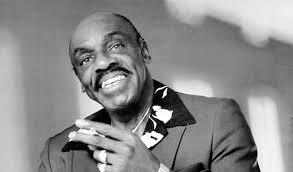Nappy Brown – A Complete Biography
Introduction
Napoleon Brown Goodson Culp — better known to the world as Nappy Brown — was a powerful-voiced R&B and blues singer whose emotionally charged delivery and gospel-rooted phrasing helped bridge 1950s rhythm & blues and the later development of soul. With a stage presence equal parts raw fervor and playful vocal ornamentation, Brown scored several R&B hits in the 1950s, enjoyed a revival among blues fans decades later, and remained an admired live performer until his final years.

Childhood
Napoleon Brown Goodson Culp was born in Charlotte, North Carolina, on October 12, 1929. He grew up in a musical, church-going environment; his family attended the AME Zion church and gospel music formed the foundation of his early musical life. After the death of his mother, he was raised within the extended family and learned to sing in church choirs and local gospel groups, honing the voice, vibrato, and melismatic phrasing that would become his trademark.
Youth
As a young man Brown became more deeply involved in gospel singing and local performances. He absorbed the fervent, call-and-response feeling of Black church music and began to experiment with secular material. Like many singers of his generation, he found opportunities to perform on local stages and in traveling shows that mixed gospel, blues, and early rhythm & blues. In the early 1950s he made the stylistic switch from strictly gospel to R&B — bringing with him the ornamented, emotional approach that made his sound unique.
Adulthood
Brown’s professional recording career began in earnest in the mid-1950s after he signed with Savoy Records. Between 1954 and the late 1950s he recorded a string of singles that made his voice familiar across jukeboxes and radio. His sound — a combination of gospel phrasing, wide vibrato, dramatic runs, and unusual little vocal flourishes (the playful “li-li-li…” ornament, for example) — set him apart from many contemporaries and earned him a devoted audience.
On stage he was known for a theatrical, exuberant delivery that drew in crowds. During his early commercial peak he toured with major R&B revues and shared billing with many of the era’s important artists. Some performers and observers have pointed to Brown’s influence on later soul singers — his combination of gospel intensity and pop phrasing prefigured aspects of artists who came after him.
Later in life Brown weathered the familiar ups and downs of a midcentury musician: changes in popular taste, record-label shifts, and the economic instability of performing life. Despite those difficulties, his reputation never entirely faded. Beginning in the 1980s a renewed interest in classic R&B and roots music brought him back into the studio and onto international stages; European promoters and blues revivalists invited him to perform, and a succession of reissues and new recordings helped reintroduce his work to younger audiences. He continued to record and perform sporadically into the 2000s, delighting longtime fans and winning new admirers with his live shows.
Major compositions (selected)
While Nappy Brown was primarily known as a vocalist and interpreter rather than a prolific songwriter, several recordings from the 1950s and beyond became closely associated with him and showcase his stylistic strengths:
- “Don’t Be Angry” — One of Brown’s biggest chart successes; its heartfelt vocal and memorable hook made it a staple of his repertoire.
- “Pitter Patter” — Another 1950s single that exemplifies Brown’s rhythmic phrasing and emotive delivery.
- “Little by Little” — A tune that highlights the smoother, pop-leaning side of his R&B work while still allowing his gospel inflections to shine.
- “It Don’t Hurt No More” — A bluesy, aching number that became part of his midcentury single output.
- “Open Up That Door” — A driving performance often cited by fans; recordings of Brown’s midcentury sides have been collected and reissued over time.
Across these songs, listeners encounter the same hallmarks: a voice that can soar into wide vibrato, sudden melismatic runs drawn from gospel technique, and a playful willingness to bend syllables and time in service of expression. Those elements are why Brown’s recordings from the 1950s remain compelling to collectors, historians, and performers.
Death
In the summer of 2008 Brown’s health declined after a period of performing. He was hospitalized in June and struggled with various ailments. On September 20, 2008, Napoleon Brown Goodson Culp died in Charlotte, North Carolina. He was 78 years old. His passing prompted obituaries and remembrances in music publications and newspapers that recalled both his midcentury hits and his later-career revival, praising his distinctive voice and energetic stage presence.
Conclusion
Nappy Brown’s story is one of vital vocal personality and resilience. Though his biggest commercial successes came in the 1950s, his influence rippled forward through the development of soul and rhythm & blues, and his rediscovery by roots and blues audiences decades later confirmed the lasting appeal of his voice. He remains remembered as a singer who brought gospel intensity to secular songs, who ornamented and stretched phrases in ways that felt both raw and artful, and who — even after commercial fame faded — continued to find ways to perform, record, and connect with listeners until the end of his life.

Comments are closed